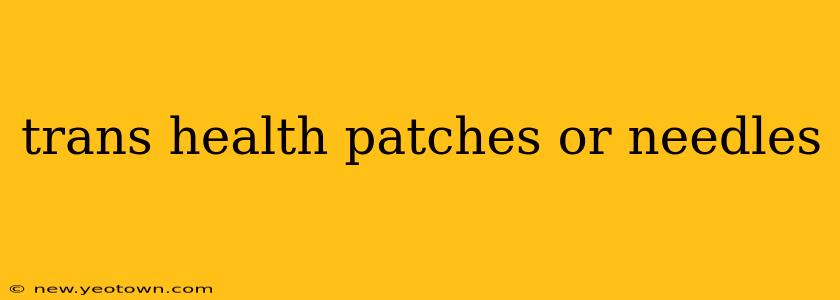Trans Health: Patches vs. Needles – A Personal Journey to Hormone Replacement Therapy (HRT)
The journey to embracing one's true gender identity is deeply personal, and for many transgender individuals, hormone replacement therapy (HRT) plays a pivotal role. This often involves a choice between two primary methods of hormone administration: patches and injections. Choosing the right method can feel overwhelming, but understanding the nuances of each can empower you to make an informed decision that aligns with your needs and lifestyle. This isn't just about hormones; it's about self-discovery and well-being.
My own story began with countless questions swirling in my head. I knew I wanted to start HRT, but the thought of needles filled me with anxiety. The idea of a transdermal patch, however, felt less daunting. But was it the right choice for me? Let's explore the key differences to help you navigate this crucial decision.
What are the different types of HRT delivery methods?
This question often arises because the options aren't always immediately clear. Beyond patches and injections, other options exist, including oral medications and subcutaneous pellets. However, patches and injections are the most common methods for delivering hormones for gender transition. Each has its own set of advantages and disadvantages that should be carefully considered.
What are the pros and cons of hormone patches for transgender people?
Patches offer a convenient, relatively painless method of hormone delivery. The hormone is absorbed through the skin, bypassing the digestive system and potentially minimizing some side effects associated with oral medications. For someone like me, initially apprehensive about needles, this was a significant advantage. However, patches aren't without drawbacks. Skin irritation is a common concern, and absorption rates can vary depending on factors like skin type and body temperature. Consistency in application is key, and the adhesive can sometimes cause discomfort. Furthermore, patch effectiveness might be affected by things like sweating or exposure to heat.
What are the pros and cons of hormone injections for transgender people?
Injections, while often perceived as more invasive, offer several advantages. They typically provide more consistent hormone levels compared to patches. This can be especially important for those seeking a smoother transition. The injection process is quick, and for many, the benefits outweigh any anxieties about needles. However, injections require regular visits to a clinic or self-administration, which might not be feasible or comfortable for everyone. Injection sites can also experience soreness or bruising, and accidental injection into a blood vessel can be risky.
Which method is more effective?
Determining which method is more effective is tricky, as it largely depends on the individual and their specific hormonal needs. Both patches and injections can be effective in achieving desired hormonal levels. The optimal choice often comes down to individual preferences, lifestyle, and medical advice from an endocrinologist specializing in transgender healthcare. A collaborative discussion with your doctor will help determine the best approach for your body and your goals.
How much do HRT patches and injections cost?
The cost of HRT varies widely based on location, insurance coverage, and the specific hormones prescribed. It's crucial to discuss costs upfront with your healthcare provider and insurance company to understand what to expect. This can be a significant factor influencing the choice between patches and injections. Financial considerations should be addressed during the initial consultation with your doctor.
Are there any long-term side effects associated with HRT?
Both patches and injections carry potential long-term side effects, although these are typically manageable with proper monitoring by a healthcare professional. These side effects can include cardiovascular issues, blood clots, and changes in liver function. Regular checkups and blood tests are essential to monitor for any complications and make adjustments to the treatment plan as needed. Open communication with your doctor is paramount in mitigating potential risks.
My journey hasn't been without its challenges. While I started with patches, eventually, my doctor and I determined that injections were a better fit for me to achieve consistent hormone levels. This is a personal anecdote, but it highlights the importance of ongoing dialogue with your healthcare provider and flexibility in your approach to HRT. Remember, the goal is to find the method that helps you feel your best, both physically and emotionally. It's a personal journey, and your comfort and well-being should always come first.

